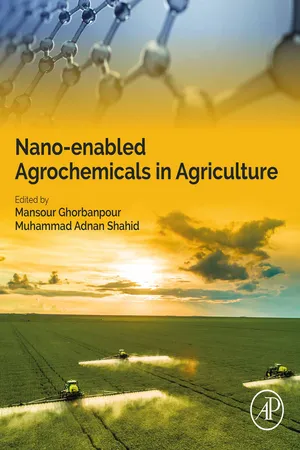
- 568 pages
- English
- ePUB (mobile friendly)
- Only available on web
Nano-enabled Agrochemicals in Agriculture
About This Book
Nano-Enabled Agrochemicals in Agriculture presents a targeted overview of the safe implementation of nanotechnologies within agricultural and horticultural settings, with the purpose of achieving enhanced production while maintaining ecological integrity. The growing global request for agricultural crops and products requires high standards of quality and safety, which has stimulated the search for new technologies that preserve their quality and delay their decomposition. Nanotechnology may boost plant production by improving nutrient uptake/use efficiency with nanoformulations of fertilizers and agrochemicals for plant enhancement, detection and treatment of diseases, and host-parasite interactions at the molecular level using nanosensors. It also may improve plant disease diagnostics, removal of contaminants from soil and water, postharvest management of vegetables and flowers, and reclamation of salt-affected soils.
Although the markets for nanoproducts and nanoformulations continue to increase, there are also growing concerns regarding the fate and behavior of nanomaterials in environmental systems. Exploring important topics related to nanotechnology and nanomaterials, the book includes the use of nanochemicals in insect pest management, as nanofungicides, nanoherbicides, micronutrient supply, and nanosensors to monitor crop and soil health conditions, from detection of agrochemicals to their slow release of agrochemicals, and their impact on related environs.
This book will serve as an excellent resource for a wide range of plant scientists who have concerns about nanomaterial interactions with terrestrial and aquatic plants.
- Focuses on emerging important topics related to nanotechnology and nanomaterials on agricultural systems
- Emphasizes new applications of nanomaterials in the agricultural sciences, from fertilizers to irrigation systems
- Addresses concerns about nanomaterial interactions with terrestrial and aquatic plants
Frequently asked questions
Information
Table of contents
- Cover
- Title page
- Table of Contents
- Copyright
- Contributors
- Chapter 1: The role of nanotechnology to combat major recent worldwide challenges
- Chapter 2: Classification of nanomaterials and their physical and chemical nature
- Chapter 3: The theory of relativity effect in nanoparticles: Deciphering of unknown effects with nano-puzzle and nano-domini
- Chapter 4: Eco-friendly routes for obtaining nanoparticles and their application in agro-industry
- Chapter 5: The mechanisms involved in the synthesis of biogenic nanoparticles
- Chapter 6: Advanced analytical techniques for physico-chemical characterization of nano-materials
- Chapter 7: Nanotechnology for cargo delivery with a special emphasis on pesticide, herbicide, and fertilizer
- Chapter 8: Nano-biofertilizers for enhanced nutrient use efficiency
- Chapter 9: Nanopriming technology for improving crop plants under stressful conditions: concept and methods
- Chapter 10: Applications of nanotechnology in precision agriculture
- Chapter 11: Algal nanoparticles and their potential application in agriculture
- Chapter 12: Silver and zinc nanoparticles in the improvement of agricultural crops
- Chapter 13: Biogenic nanoparticles and their application for removal of organic contaminants from water and wastewater
- Chapter 14: Stimulatory role of nanomaterials on agricultural crops
- Chapter 15: Green synthesis of nanoparticles and their uses in agriculture
- Chapter 16: A comprehensive review on nanopesticides and nanofertilizers—A boon for agriculture
- Chapter 17: Nano-enabled agrochemicals for sustainable agriculture
- Chapter 18: Synthesis of nanofungicides by encapsulating fungicide nanoparticles using functionalized graphene and its application against phytopathogenic Rhizoctonia solani
- Chapter 19: Effects of nanoparticles on phytotoxicity, cytotoxicity, and genotoxicity in agricultural crops
- Chapter 20: Engineered nanomaterial-mediated changes in the growth and development of common agricultural crops
- Chapter 21: Biosynthesis and green synthesis of nanoparticles and their use in agriculture
- Chapter 22: Nanoparticle-based solutions for diagnosis and management of fungal plant pathogens
- Chapter 23: Current status and future prospects of nanoparticles as plant genetic materials carrier
- Chapter 24: Current developments in nanotechnology for the growth of different industrial sectors: 2010–20
- Chapter 25: Impacts of nanomaterials on metabolic profiling of agricultural crops
- Chapter 26: Polymeric nanoparticle-based insecticide: A critical review of agriculture production
- Chapter 27: Nano–delivery system: In the agriculture sector
- Chapter 28: Nanotechnology, a new tool for agriculture and agroindustry
- Chapter 29: Synthesis of different TiO2 nanostructures using central composite design optimization method and application of TiO2-nanobelt for water microorganism's purification
- Index